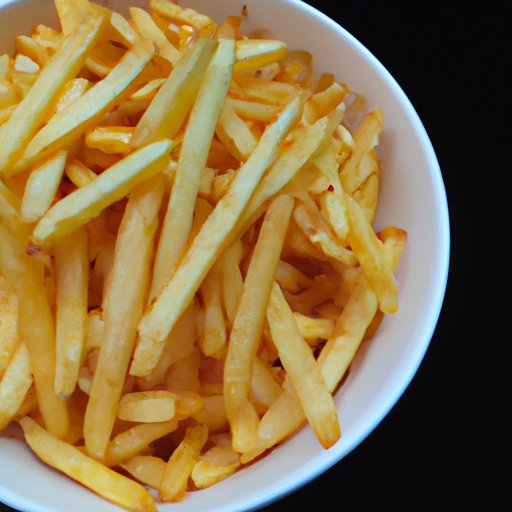
Introduction
Few things are as satisfying as a plate of crispy, perfectly cooked french fries. But for many of us, attempts to recreate that restaurant-quality crunch at home often result in soggy, lackluster spuds. But making perfect french fries at home is easier than you may think. In this article, we’ll provide you with a step-by-step guide to achieving crispy, golden fries every time. And if you’re looking to up your fry game, we’ve got you covered with tips for seasoning, unique toppings, and even healthier options. Let’s get cooking!
A Step-by-Step Guide to Making Perfect Crispy French Fries at Home
The key to perfect fries is starting with the right potatoes. Russet potatoes are the best choice, as they contain less water and more starch than other varieties, which means crispier fries. Before we start, make sure to clean and peel the potatoes. Let’s cut the potatoes into thin sticks, about ¼ inch thick.
After cutting the potatoes, we’ll need to rinse them in cold water to remove excess starch. Then, it’s time to fry. We recommend using a deep fryer or a large, deep pot filled with oil heated to 375°F – this will ensure crispy fries every time.
To make sure the oil is at the right temperature, we need to use a thermometer. Once the oil reaches 375°F, carefully add the potatoes to the oil using a slotted spoon or tongs. Fry the potatoes for 5-7 minutes or until golden brown.
Once the fries are cooked, transfer them to a paper towel-lined plate to absorb excess oil and season with salt while still hot. For added flavor, experiment with different seasoning blends such as garlic powder, paprika, or cajun spices. Serve and enjoy!
The Science of French Fries
While the process of making perfect french fries may seem simple, there’s actually quite a bit of science behind it. The texture and taste of french fries are affected by a variety of factors, including the chemistry of frying.
One key process in making french fries is the Maillard reaction, which occurs when the sugars in the potatoes react with the high heat of the oil, resulting in the crispy outer layer. The temperature of the oil, the sugar content in the potatoes, and the frying time can all affect the final product.
A History of French Fries and Their Global Variations
While we often associate french fries with fast food chains, they actually have a rich history that goes back centuries. The origins of french fries can be traced back to 17th-century Belgium, where villagers fried small fish in hot oil. When the weather made fishing impossible, they turned to potatoes as a substitute, giving birth to the modern-day french fry.
Today, french fries are enjoyed all over the world, and different countries have their own unique takes on the classic dish. In Canada, poutine offers a mix of fries, cheese curds, and gravy, while in Peru, fries are often topped with spicy aji sauce and chicken or beef.
Creative Toppings for French Fries
While ketchup or cheese sauce may be the go-to toppings for french fries, why not get a little creative? Here are a few ideas to get you started:
- Truffle fries, drizzled with truffle oil and finished with grated parmesan cheese
- Breakfast fries topped with scrambled eggs, bacon, and cheese
- Tzatziki fries served with a tangy cucumber-yogurt dipping sauce
- Loaded fries topped with pulled pork, BBQ sauce, and coleslaw
And don’t forget – different types of fries (such as curly or sweet potato fries) can be paired with different toppings, so don’t be afraid to experiment.
Healthier Options for Homemade French Fries
While french fries may not be the healthiest snack, there are ways to enjoy them with a little less guilt. One option is to use an air fryer, instead of a traditional deep fryer, which reduces the amount of oil used. You can also bake fries in the oven, using a bit of oil and fresh herbs for seasoning.
Another way to make healthier fries is by choosing different types of potatoes – sweet potatoes, for example, are lower in starch and contain more nutrients than traditional russet potatoes. Finally, experiment with different seasoning blends to add flavor without extra calories.
Conclusion
Now that you’ve learned the art of making perfect french fries, the sky’s the limit. Whether you’re looking for new seasoning blends or unique toppings, there are endless ways to get creative with this classic dish. And with the tips for healthier options, you can indulge in this delicious treat without the guilt. Just remember to start with the right potatoes and follow our step-by-step guide, and you’ll be on your way to crispy, golden fries every time.





